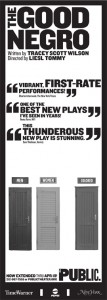Liesl Tommy Directs THE GOOD NEGRO at the Public Theatre in New York
 I am thrilled that Liesl Tommy will be returning to Shepherdstown to direct The World Premiere of THE HISTORY OF LIGHT by Eisa Davis. Her production of STICK FLY by Lydia Diamond was such a great success last summer. She is currently directing Tracey Scott Wilson’s bold new play at the Public Theatre in NY. So if you are in New York please check out this important new play. Here is Liesl in her own words:
I am thrilled that Liesl Tommy will be returning to Shepherdstown to direct The World Premiere of THE HISTORY OF LIGHT by Eisa Davis. Her production of STICK FLY by Lydia Diamond was such a great success last summer. She is currently directing Tracey Scott Wilson’s bold new play at the Public Theatre in NY. So if you are in New York please check out this important new play. Here is Liesl in her own words:
Well, after five long years of work The Good Negro finally sees the light of production. I am so proud of the writer, designers, actors and producers; some of whom put years of dedication and passion into what we are now presenting at the Public Theatre. We have also had some wonderful notices and features for the show:
Reviews:
Bloomberg (John Simon)
The New York Times (Charles Isherwood)
Variety
Time Out NY
AP (Mike Kuchwara)
Back Stage (Andy Propst)
NYTheatre.com (Martin Denton)
Talkin’ Broadway (Matthew Murray)
CurtainUp (Elyse Sommer)
New Theater Corps (Aaron Riccio)Features:
NYTimes Interview of Tracey Scott Wilson and Liesl Tommy
NYTimes Slideshow of the productionI also wanted to let you know what my schedule holds for the next few months. I have 4 WORLD PREMIERES of new plays coming up: Angela’s Mixtape by Eisa Davis, History of Light by Eisa Davis, Eclipsed by Danai Gurira, and Peggy Pickett Sees the Face of God by Roland Schimmelpfennig.
April: Angela’s Mixtape by Eisa Davis – New Georges (NY, NY) Premiere
July/August: History of Light by Eisa Davis- Contemporary American Theater Festival (Shepherdstown, WV) Premiere
July/August: Yankee Tavern by Steven Dietz- Contemporary American Theater Festival (Shepherdstown, WV) Premiere
September: Eclipsed by Danai Gurira – Woolly Mammoth Theatre (Washington DC) Premiere
Oct/Nov: Eclipsed by Danai Gurira – Yale Rep (New Haven, CT) Premiere
June Africa Trilogy Project: Peggy Pickett Sees the Face of God by Roland Schimmelpfennig – Luminato Festival (Toronto, CA) Premiere
